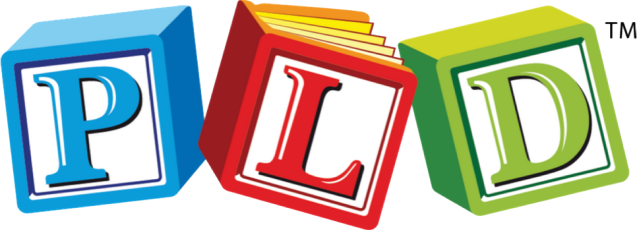Early Years Literacy & Learning Resources
Which programs are you looking for?
Oral Language
Literacy
Movement & Motor
Decodable Readers
Starter Packs
Bundles
Downloads
-
Comprehension Questions for 4 Year Olds
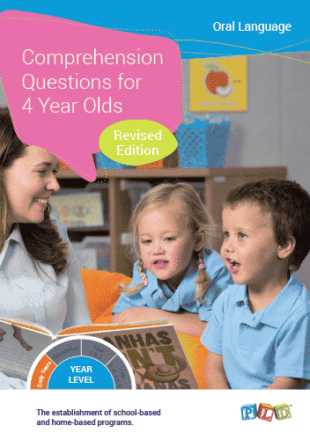
A home or school picture book program for 4 Year Old students.
The aim of Comprehension Questions for 4 Year olds is to train parents and teachers to ask developmentally appropriate questions and to evaluate the quality of a child’s oral answer. If an insufficient answer is provided by a child, there are examples of how to assist the child to answer the question specifically with sufficient information. From 4 Years Old, students should love engaging with their peers and adults. Therefore, the ability to understand questions is critical for participation in social interactions and success across all curriculum areas. Comprehension Questions for 4 Year Olds has been developed as an essential resource for Oral Language Development. At this age, questions become more complex with the child required to understand or comment on the attributes which may not be obvious, to make predictions and sequence information. For example: What is this part used for? What happened next? How did you feel? How did you make it? Designed by Speech Pathologists for teachers and parents for use in schools, daycare and in the home this program provides 4 year olds with: Lists of developmentally appropriate picture books and comprehension questions. Samples of 4 year old age-appropriate answers and samples of inadequate 4 year old answers. Techniques and strategies to implement when a child provides an inadequate answer. An instruction booklet that outlines how the resource can be presented to a whole class, small groups or individual home setting. Each card reminds the importance of repeated reading of picture books and outlines a collection of questions to be asked on day 1, then further questions to be asked on days 2, 3 and 4. 41 cards that model appropriate questions and responses for the books listed in Recommended Books For 4 Year Olds such as ‘Piranhas Don’t Eat Bananas’, ‘Possum Goes to School’, ‘We’re Going on a Bear Hunt’, and the ‘Wonky Donkey’. The questions focus primarily upon Blank (level 2 and 3 questions). Two easy to administer progress checks; are included, to check on the acquisition of comprehension questioning ability. The other programs within the range include: Comprehension Questions for 3 year olds (Mc3) Explanation video for parent training Comprehension Questions for 4 year olds (Mc4) Explanation video for parent training Comprehension Questions for 5 year olds (Mc5) Explanation video for parent training Comprehension Questions for 6 & 7 year olds (Mc6) Explanation video for parent training Comprehension Questions for 8 & 9 year olds (Mc8) Explanation video for parent training Full set of Comprehension Questions Programs Related Article: Boost Reading Comprehension This product is mentioned in the Early Years Teaching Sequence Manual on page 9.
From $65.00$65.00 incl. GST[flipbook-popup id=''][/flipbook-popup] -
10 Minute Language Games – Set 1
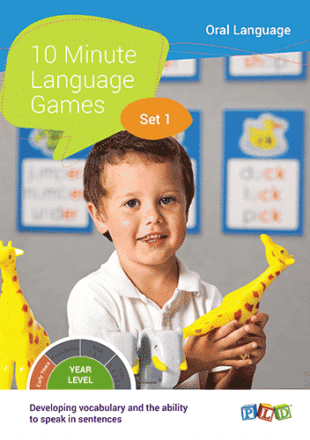
Developing vocabulary and the ability to speak in sentences.
The aim of Comprehension Questions for 4 Year olds is to train parents and teachers to ask developmentally appropriate questions and to evaluate the quality of a child’s oral answer. If an insufficient answer is provided by a child, there are examples of how to assist the child to answer the question specifically with sufficient information. From 4 Years Old, students should love engaging with their peers and adults. Therefore, the ability to understand questions is critical for participation in social interactions and success across all curriculum areas. Comprehension Questions for 4 Year Olds has been developed as an essential resource for Oral Language Development. At this age, questions become more complex with the child required to understand or comment on the attributes which may not be obvious, to make predictions and sequence information. For example: What is this part used for? What happened next? How did you feel? How did you make it? Designed by Speech Pathologists for teachers and parents for use in schools, daycare and in the home this program provides 4 year olds with: Lists of developmentally appropriate picture books and comprehension questions. Samples of 4 year old age-appropriate answers and samples of inadequate 4 year old answers. Techniques and strategies to implement when a child provides an inadequate answer. An instruction booklet that outlines how the resource can be presented to a whole class, small groups or individual home setting. Each card reminds the importance of repeated reading of picture books and outlines a collection of questions to be asked on day 1, then further questions to be asked on days 2, 3 and 4. 41 cards that model appropriate questions and responses for the books listed in Recommended Books For 4 Year Olds such as ‘Piranhas Don’t Eat Bananas’, ‘Possum Goes to School’, ‘We’re Going on a Bear Hunt’, and the ‘Wonky Donkey’. The questions focus primarily upon Blank (level 2 and 3 questions). Two easy to administer progress checks; are included, to check on the acquisition of comprehension questioning ability. The other programs within the range include: Comprehension Questions for 3 year olds (Mc3) Explanation video for parent training Comprehension Questions for 4 year olds (Mc4) Explanation video for parent training Comprehension Questions for 5 year olds (Mc5) Explanation video for parent training Comprehension Questions for 6 & 7 year olds (Mc6) Explanation video for parent training Comprehension Questions for 8 & 9 year olds (Mc8) Explanation video for parent training Full set of Comprehension Questions Programs Related Article: Boost Reading Comprehension This product is mentioned in the Early Years Teaching Sequence Manual on page 9.
From $65.00$65.00 incl. GST[flipbook-popup id=''][/flipbook-popup] -
Semantic Scenes and Questioning – Set 1
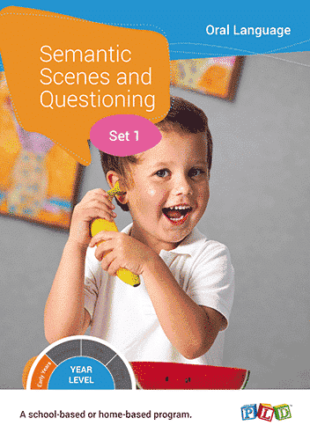
A school-based or home-based program designed to equip teachers and parents of 3-4 year old children with activities that will develop semantic knowledge.
The aim of Comprehension Questions for 4 Year olds is to train parents and teachers to ask developmentally appropriate questions and to evaluate the quality of a child’s oral answer. If an insufficient answer is provided by a child, there are examples of how to assist the child to answer the question specifically with sufficient information. From 4 Years Old, students should love engaging with their peers and adults. Therefore, the ability to understand questions is critical for participation in social interactions and success across all curriculum areas. Comprehension Questions for 4 Year Olds has been developed as an essential resource for Oral Language Development. At this age, questions become more complex with the child required to understand or comment on the attributes which may not be obvious, to make predictions and sequence information. For example: What is this part used for? What happened next? How did you feel? How did you make it? Designed by Speech Pathologists for teachers and parents for use in schools, daycare and in the home this program provides 4 year olds with: Lists of developmentally appropriate picture books and comprehension questions. Samples of 4 year old age-appropriate answers and samples of inadequate 4 year old answers. Techniques and strategies to implement when a child provides an inadequate answer. An instruction booklet that outlines how the resource can be presented to a whole class, small groups or individual home setting. Each card reminds the importance of repeated reading of picture books and outlines a collection of questions to be asked on day 1, then further questions to be asked on days 2, 3 and 4. 41 cards that model appropriate questions and responses for the books listed in Recommended Books For 4 Year Olds such as ‘Piranhas Don’t Eat Bananas’, ‘Possum Goes to School’, ‘We’re Going on a Bear Hunt’, and the ‘Wonky Donkey’. The questions focus primarily upon Blank (level 2 and 3 questions). Two easy to administer progress checks; are included, to check on the acquisition of comprehension questioning ability. The other programs within the range include: Comprehension Questions for 3 year olds (Mc3) Explanation video for parent training Comprehension Questions for 4 year olds (Mc4) Explanation video for parent training Comprehension Questions for 5 year olds (Mc5) Explanation video for parent training Comprehension Questions for 6 & 7 year olds (Mc6) Explanation video for parent training Comprehension Questions for 8 & 9 year olds (Mc8) Explanation video for parent training Full set of Comprehension Questions Programs Related Article: Boost Reading Comprehension This product is mentioned in the Early Years Teaching Sequence Manual on page 9.
From $65.00$65.00 incl. GST[flipbook-popup id=''][/flipbook-popup] -
Comprehension Questions for 3 Year Olds
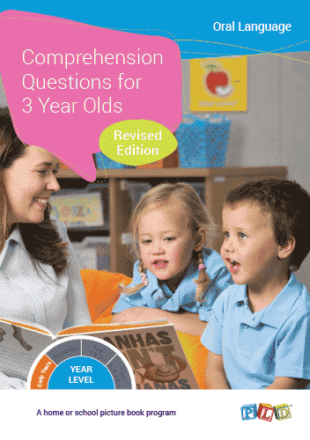
A home or school picture book program for 3 year olds.
The aim of Comprehension Questions for 4 Year olds is to train parents and teachers to ask developmentally appropriate questions and to evaluate the quality of a child’s oral answer. If an insufficient answer is provided by a child, there are examples of how to assist the child to answer the question specifically with sufficient information. From 4 Years Old, students should love engaging with their peers and adults. Therefore, the ability to understand questions is critical for participation in social interactions and success across all curriculum areas. Comprehension Questions for 4 Year Olds has been developed as an essential resource for Oral Language Development. At this age, questions become more complex with the child required to understand or comment on the attributes which may not be obvious, to make predictions and sequence information. For example: What is this part used for? What happened next? How did you feel? How did you make it? Designed by Speech Pathologists for teachers and parents for use in schools, daycare and in the home this program provides 4 year olds with: Lists of developmentally appropriate picture books and comprehension questions. Samples of 4 year old age-appropriate answers and samples of inadequate 4 year old answers. Techniques and strategies to implement when a child provides an inadequate answer. An instruction booklet that outlines how the resource can be presented to a whole class, small groups or individual home setting. Each card reminds the importance of repeated reading of picture books and outlines a collection of questions to be asked on day 1, then further questions to be asked on days 2, 3 and 4. 41 cards that model appropriate questions and responses for the books listed in Recommended Books For 4 Year Olds such as ‘Piranhas Don’t Eat Bananas’, ‘Possum Goes to School’, ‘We’re Going on a Bear Hunt’, and the ‘Wonky Donkey’. The questions focus primarily upon Blank (level 2 and 3 questions). Two easy to administer progress checks; are included, to check on the acquisition of comprehension questioning ability. The other programs within the range include: Comprehension Questions for 3 year olds (Mc3) Explanation video for parent training Comprehension Questions for 4 year olds (Mc4) Explanation video for parent training Comprehension Questions for 5 year olds (Mc5) Explanation video for parent training Comprehension Questions for 6 & 7 year olds (Mc6) Explanation video for parent training Comprehension Questions for 8 & 9 year olds (Mc8) Explanation video for parent training Full set of Comprehension Questions Programs Related Article: Boost Reading Comprehension This product is mentioned in the Early Years Teaching Sequence Manual on page 9.
From $65.00$65.00 incl. GST[flipbook-popup id=''][/flipbook-popup] -
Developing News Telling and Narrative Skills For 4 Year Olds
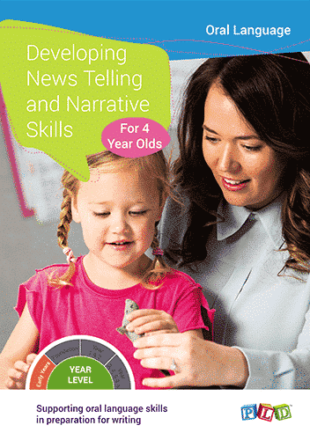
Oral language preparation for writing including show and tell, activity retells & news telling.
The aim of Comprehension Questions for 4 Year olds is to train parents and teachers to ask developmentally appropriate questions and to evaluate the quality of a child’s oral answer. If an insufficient answer is provided by a child, there are examples of how to assist the child to answer the question specifically with sufficient information. From 4 Years Old, students should love engaging with their peers and adults. Therefore, the ability to understand questions is critical for participation in social interactions and success across all curriculum areas. Comprehension Questions for 4 Year Olds has been developed as an essential resource for Oral Language Development. At this age, questions become more complex with the child required to understand or comment on the attributes which may not be obvious, to make predictions and sequence information. For example: What is this part used for? What happened next? How did you feel? How did you make it? Designed by Speech Pathologists for teachers and parents for use in schools, daycare and in the home this program provides 4 year olds with: Lists of developmentally appropriate picture books and comprehension questions. Samples of 4 year old age-appropriate answers and samples of inadequate 4 year old answers. Techniques and strategies to implement when a child provides an inadequate answer. An instruction booklet that outlines how the resource can be presented to a whole class, small groups or individual home setting. Each card reminds the importance of repeated reading of picture books and outlines a collection of questions to be asked on day 1, then further questions to be asked on days 2, 3 and 4. 41 cards that model appropriate questions and responses for the books listed in Recommended Books For 4 Year Olds such as ‘Piranhas Don’t Eat Bananas’, ‘Possum Goes to School’, ‘We’re Going on a Bear Hunt’, and the ‘Wonky Donkey’. The questions focus primarily upon Blank (level 2 and 3 questions). Two easy to administer progress checks; are included, to check on the acquisition of comprehension questioning ability. The other programs within the range include: Comprehension Questions for 3 year olds (Mc3) Explanation video for parent training Comprehension Questions for 4 year olds (Mc4) Explanation video for parent training Comprehension Questions for 5 year olds (Mc5) Explanation video for parent training Comprehension Questions for 6 & 7 year olds (Mc6) Explanation video for parent training Comprehension Questions for 8 & 9 year olds (Mc8) Explanation video for parent training Full set of Comprehension Questions Programs Related Article: Boost Reading Comprehension This product is mentioned in the Early Years Teaching Sequence Manual on page 9.
From $65.00$65.00 incl. GST[flipbook-popup id=''][/flipbook-popup] -
Speech Development Screen
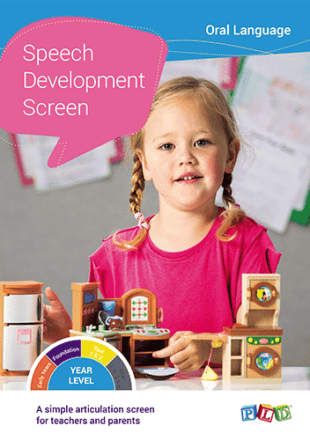
A simple articulation screen for teachers and parents.
Designed by Speech Pathologists for use in early childhood centres, schools and the home. The screen is quick and simple to administer. The screen identifies
$82.50[flipbook-popup id=''][/flipbook-popup] -
Picture Book Recounting – Step 1
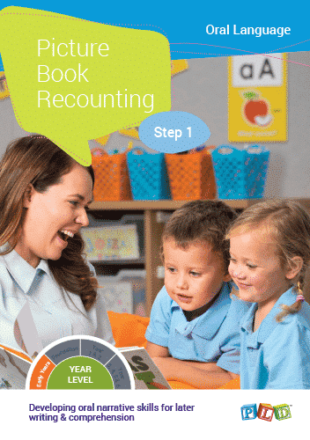
Developing oral narrative skills for later writing & comprehension.
The aim of Comprehension Questions for 4 Year olds is to train parents and teachers to ask developmentally appropriate questions and to evaluate the quality of a child’s oral answer. If an insufficient answer is provided by a child, there are examples of how to assist the child to answer the question specifically with sufficient information. From 4 Years Old, students should love engaging with their peers and adults. Therefore, the ability to understand questions is critical for participation in social interactions and success across all curriculum areas. Comprehension Questions for 4 Year Olds has been developed as an essential resource for Oral Language Development. At this age, questions become more complex with the child required to understand or comment on the attributes which may not be obvious, to make predictions and sequence information. For example: What is this part used for? What happened next? How did you feel? How did you make it? Designed by Speech Pathologists for teachers and parents for use in schools, daycare and in the home this program provides 4 year olds with: Lists of developmentally appropriate picture books and comprehension questions. Samples of 4 year old age-appropriate answers and samples of inadequate 4 year old answers. Techniques and strategies to implement when a child provides an inadequate answer. An instruction booklet that outlines how the resource can be presented to a whole class, small groups or individual home setting. Each card reminds the importance of repeated reading of picture books and outlines a collection of questions to be asked on day 1, then further questions to be asked on days 2, 3 and 4. 41 cards that model appropriate questions and responses for the books listed in Recommended Books For 4 Year Olds such as ‘Piranhas Don’t Eat Bananas’, ‘Possum Goes to School’, ‘We’re Going on a Bear Hunt’, and the ‘Wonky Donkey’. The questions focus primarily upon Blank (level 2 and 3 questions). Two easy to administer progress checks; are included, to check on the acquisition of comprehension questioning ability. The other programs within the range include: Comprehension Questions for 3 year olds (Mc3) Explanation video for parent training Comprehension Questions for 4 year olds (Mc4) Explanation video for parent training Comprehension Questions for 5 year olds (Mc5) Explanation video for parent training Comprehension Questions for 6 & 7 year olds (Mc6) Explanation video for parent training Comprehension Questions for 8 & 9 year olds (Mc8) Explanation video for parent training Full set of Comprehension Questions Programs Related Article: Boost Reading Comprehension This product is mentioned in the Early Years Teaching Sequence Manual on page 9.
From $65.00$65.00 incl. GST[flipbook-popup id=''][/flipbook-popup] -
Activity Recounts
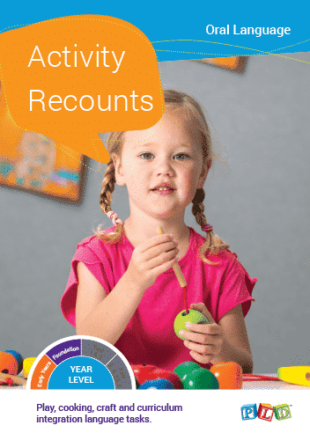
Developing language within the early years
The aim of Comprehension Questions for 4 Year olds is to train parents and teachers to ask developmentally appropriate questions and to evaluate the quality of a child’s oral answer. If an insufficient answer is provided by a child, there are examples of how to assist the child to answer the question specifically with sufficient information. From 4 Years Old, students should love engaging with their peers and adults. Therefore, the ability to understand questions is critical for participation in social interactions and success across all curriculum areas. Comprehension Questions for 4 Year Olds has been developed as an essential resource for Oral Language Development. At this age, questions become more complex with the child required to understand or comment on the attributes which may not be obvious, to make predictions and sequence information. For example: What is this part used for? What happened next? How did you feel? How did you make it? Designed by Speech Pathologists for teachers and parents for use in schools, daycare and in the home this program provides 4 year olds with: Lists of developmentally appropriate picture books and comprehension questions. Samples of 4 year old age-appropriate answers and samples of inadequate 4 year old answers. Techniques and strategies to implement when a child provides an inadequate answer. An instruction booklet that outlines how the resource can be presented to a whole class, small groups or individual home setting. Each card reminds the importance of repeated reading of picture books and outlines a collection of questions to be asked on day 1, then further questions to be asked on days 2, 3 and 4. 41 cards that model appropriate questions and responses for the books listed in Recommended Books For 4 Year Olds such as ‘Piranhas Don’t Eat Bananas’, ‘Possum Goes to School’, ‘We’re Going on a Bear Hunt’, and the ‘Wonky Donkey’. The questions focus primarily upon Blank (level 2 and 3 questions). Two easy to administer progress checks; are included, to check on the acquisition of comprehension questioning ability. The other programs within the range include: Comprehension Questions for 3 year olds (Mc3) Explanation video for parent training Comprehension Questions for 4 year olds (Mc4) Explanation video for parent training Comprehension Questions for 5 year olds (Mc5) Explanation video for parent training Comprehension Questions for 6 & 7 year olds (Mc6) Explanation video for parent training Comprehension Questions for 8 & 9 year olds (Mc8) Explanation video for parent training Full set of Comprehension Questions Programs Related Article: Boost Reading Comprehension This product is mentioned in the Early Years Teaching Sequence Manual on page 9.
From $65.00$65.00 incl. GST[flipbook-popup id=''][/flipbook-popup] -
Speech and language developmental milestones – now that I am 3 years old…
A poster designed to promote awareness of early oral language developmental milestones in 3 Year Olds
Designed by Speech Pathologists, this resource promotes awareness of early oral language developmental milestones. The poster outlines: What children aged 3 years should be able
$6.05[flipbook-popup id=''][/flipbook-popup]


